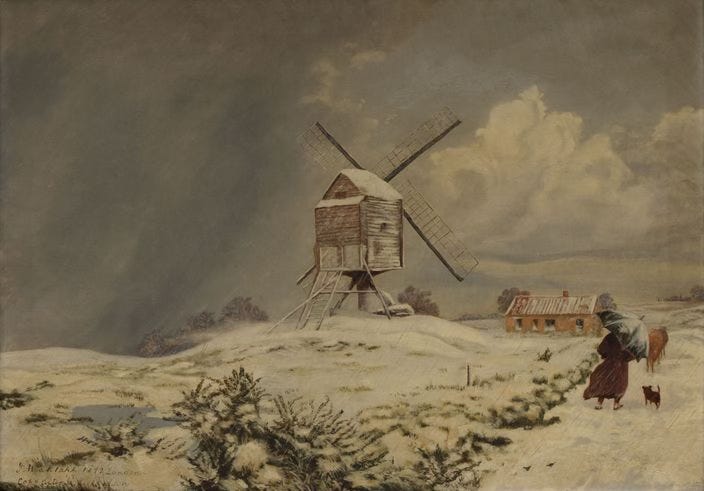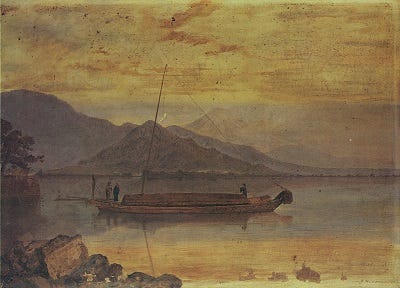Hyakutake Kaneyuki – The Diplomat
The first issue of a two-part series on the life and work of Hyakutake Kaneyuki, both a pioneering Japanese diplomat and painter active in the late 19th century.

Hyakutake Kaneyuki was a Japanese diplomat and pioneering Western-style painter during the Meiji period. Despite never working as a professional artist, he became an early pioneer of Western-style painting in Japan. Serving as a diplomat in Europe representing the fledgling Meiji government, Hyakutake was among the first Japanese to study painting in person at the world’s leading art centers in London, Paris, and Rome, all while fulfilling his official duties. Remarkably, he became the first Japanese artist to have an oil painting showcased at an exhibition abroad, and he is credited with creating some of the earliest nude oil paintings by a Japanese artist.
In this first issue of a two-part series on the life and work of Hyakutake Kaneyuki, I would like to look at his upbringing and early career as a diplomat that allowed him to pursue an education abroad.
Early life
Hyakutake was born in 1842 into a family of samurai who served the Saga Domain. Coming from a family that was a senior vassal of the ruling Nabeshima clan, he was chosen at age eight to serve as a study companion to Nabeshima Naohiro, the heir who would eventually become the last Daimyō of Saga. This was the beginning of a lifelong friendship.
Although Nabeshima was four years younger, Hyakutake trusted him like an older brother and served as his close aide for the rest of his life. During his youth, Hyakutake is said to have been taught calligraphy and Bunjin-ga (literati painting) as well as Japanese and Chinese studies by Furukawa Matsune, a scholar of Japanese classics who worked for Nabeshima's father. In the early 1860s, around the age of twenty, Hyakutake received first English language lessons — a remarkably rare opportunity at the time.

A turn to the West
Nabeshima Naohiro succeeded his father as Daimyō in 1861, and he continued the latter’s progressive efforts to introduce Western science and technology to the Saga Domain. This included an educational focus on the dominant powers of the time, such as Dutch studies in the 1840s and English studies from the 1860s, as well as the development of steel refining, steam engines, and artillery. Even after Nabeshima’s appointment, Hyakutake continued to serve as his close assistant, accompanying him on official business.
The Saga Domain’s affinity for foreign knowledge may have owed to its geographical location, encompassing most of what are now Japan’s Saga and Nagasaki Prefectures. Off the port of Nagasaki was Dejima, an artificial island that served as a trading post for the Portuguese (1570–1639) and subsequently the Dutch (1641–1858). For over 200 years, it was the central conduit for foreign trade and cultural exchange with Japan during the isolationist Edo period (1600–1869), and the only Japanese territory open to Westerners.

Following the political reforms of the Meiji Restoration that began in 1868, feudal class privileges were eliminated, and Japan’s domain system was replaced by prefectures governed by a central government. Despite the profound changes in the political system, which implemented meritocratic ideals, Nabeshima became a high-ranking government official, like many of the aristocratic elite.
Before the Meiji Restoration, Japan had been largely secluded from the world for centuries. The turning point came about a decade earlier when the American expedition of Commodore Matthew Perry brought four warships to Edo Bay in 1853 and forced the shogunate to open the country to foreign trade and relations. The so-called “unequal treaties” brought about political unrest, culminating in the Meiji Restoration that galvanized Japan as a unified nation. Its new leaders were intent on achieving parity — or at least the perception of parity— with the powerful West. They resolved to urgently embrace Western civilization to prevent Japan from becoming a colony of a foreign empire, and to join the international community as a modern nation.
To these ends, the Meiji government pursued policies to strengthen the military and “enrich” the country by promoting education, industry, and commerce. A key part of this effort was a program to systematically send students abroad. Students were expected to study military affairs, politics, economics, education, and social issues, and to contribute to Japan through research and by taking leadership roles upon their return.
As the last article of the Charter Oath of 1868 declared, “Knowledge shall be sought throughout the world so as to strengthen the foundations of Imperial rule.”
In October 1871, the Meiji Emperor issued an edict encouraging the nobility to travel and study abroad. It emphasized that for Japan to modernize and join the international community, its people must be diligent and its nobility must visit advanced countries to acquire the appropriate knowledge. Notably, the Emperor advised nobles to travel with their wives and daughters to observe and learn from foreign educational and childcare practices.
Embarking on the Iwakura Mission
Nabeshima and his father were already convinced that acquiring broad knowledge of the world was a prerequisite for success, so much so that they began planning to study abroad a year before the Emperor’s edict. Thanks to connections with government minister Iwakura Tomomi, who was largely responsible for promulgating the Charter Oath, Nabeshima was appointed to join a landmark mission to the West in 1871. Hyakutake accompanied him — the beginning of his path to Western painting.
The Iwakura Mission sent over 100 Japanese leaders, government officials, scholars, and students on an expedition to the United States and Europe, in search of the blueprints for building a modern Japanese nation.
On December 23, 1871, Hyakutake sailed with the delegation from Yokohama to San Francisco. After spending more than six months surveying the U.S. from coast to coast, the Iwakura mission sailed from the port of Boston to continue its tour in Europe. Separating from the main delegation in Washington, Nabeshima and Hyakutake then departed on a steamship to London, where they pursued their own mission: to study at Oxford University.
Discovering art in London
Nabeshima and Hyakutake eventually arrived at the heart of the British Empire around February 1872. They settled in northeast London, staying at the residence of a British doctor. After taking lessons to improve their English, they both enrolled at Oxford University in 1873. Nabeshima took up English literature while Hyakutake studied economics. They became, along with other members of the Iwakura delegation, the first Japanese to study at Oxford University.
During his studies, Nabeshima traveled around Britain, making an effort to interact with the aristocracy and socialize as “Prince Nabeshima.” Hyakutake, who was part of his entourage, is believed to have helped organize the events and accompanied him to the venues. Nabeshima's wife Taneko also actively participated in various efforts to acquire the social skills of a “Western lady.”

Beginning in 1875 she took painting lessons from Thomas Miles Richardson Jr.; feeling uncomfortable being alone with a male artist, she asked Hyakutake to accompany her and join the lessons. Fascinated by this firsthand experience with Western art, Hyakutake continued to study Western oil painting techniques while carrying out his professional duties.

Richardson visited Nabeshima's house once a week to give Taneko and Hyakutake lessons. A landscape painter like his father, Richardson exhibited at the Royal Academy and loved to paint the Italian countryside and the Scottish Highlands. For practice, Hyakutake copied some of Richardson's paintings, including Landscape with a Windmill in 1877. Hyakutake may have joined him on his regular visits to Scotland, and during a trip north in 1878 he painted Barnard Castle.

Hyakutake was in his early thirties at the time and had just started to study Western painting. But by the following year, Hyakutake exhibited one of his oil paintings, View from Yokohama, Japan, at the 1876 Summer Exhibition of the Royal Academy. Hyakutake was not only the first Japanese to exhibit at the Summer Exhibition, but also the first to show an oil painting at an overseas exhibition.
Unfortunately, the whereabouts of this painting are today unknown. Tagonoura zu (View of Tagonoura Bay), dated to 1876, might be a representative work of this period with a similar theme. There is even speculation that it was the picture shown at the Royal Academy with a different title that is more descriptive to an English audience.

These were Hyakutake Kaneyuki's first steps in exploring the European art world.
In the next issue, we follow him on his travels to Rome and Paris. There he has the opportunity to further hone his talent as a painter while performing his official duties as a diplomat. We'll see how his painting skills quickly mature and reveal the long-lost Reclining Nude, which earned him a well-deserved place in Japanese art history.
Thank your for reading The Arts of Japan’s Substack newsletter.
I hope you enjoyed it! If you did, please take a moment to hit the heart button at the top of the email or in the Substack app.
Feel free to leave a comment! I would love to hear your thoughts. If you have additional information on the subject or found an error, your constructive feedback is always welcome too.
And, of course, feel free to share the post or subscribe to The Arts of Japan if you haven’t yet done so:
Stefan Yanku adapted this Substack issue from an article he published on The Arts of Japan’s website. For further credits and references, please visit the original article at https://artsofjapan.com/en/profiles/hyakutake-kaneyuki
The header illustration of Hyakutake Kaneyuki Goyo was created by Takahashi Tsunemasa for The Arts of Japan.
For copyrights and usage permissions, please refer to the statement on our website, available at https://artsofjapan.com/en/impressum.





Hi Kjeld,
Thank you for your comment!
Unfortunately, the whereabouts of this painting are unknown. (I mentioned that in the original article on my website but cut it from the Substack version for brevity...) That's the English title of the painting, as it was listed at the Royal Academy and mentioned in a newspaper review by The Times about the exhibition.
You can access the source "Britain and Japan: Biographical Portraits" here: https://archive.org/details/britainjapanbiog0000unse/page/718/mode/2up?q=hyakutake+kaneyuki
Art historian Miwa Hideo speculates in Kindai no Bijutsu No. 53 (1979) that it was actually the same painting as 田子の浦図 (View of Tagonoura Bay), which you view here: https://saga-museum.jp/museum/exhibition/limited/2016/12/001465.html
Looking this up again, I noticed that I made a mistake: The title actually was "View from Yokohama, Japan" at the Royal Academy, and "View from Yokohama" in The Time's review.
So I'll make a correction, and perhaps a clarification.
I did a very quick online search for Hyakutake's "View near Yokohama in Japan" but get no immediate results. Does the painting still exist?